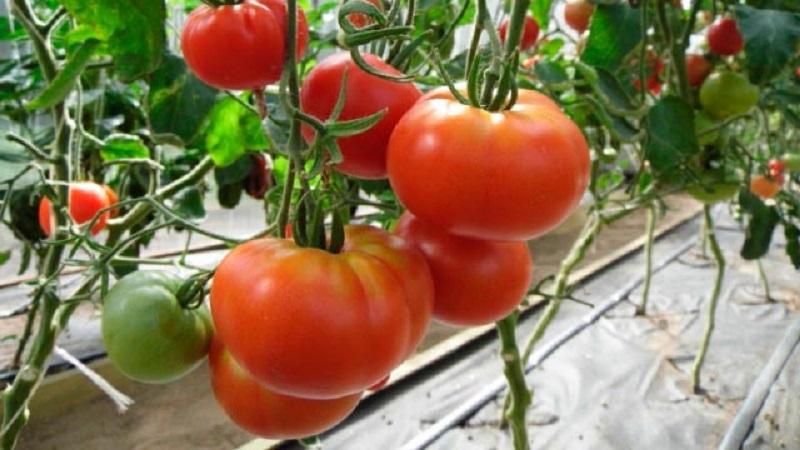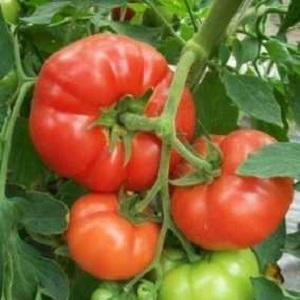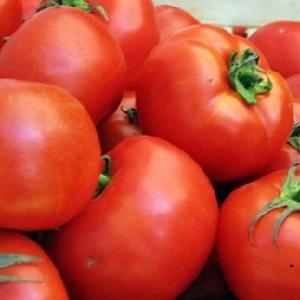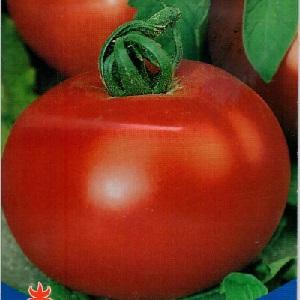Large and easy-to-care tomato "Family f1": we grow ourselves, avoiding mistakes
Tomatoes are widespread on all continents except Antarctica. From a scientific point of view, a tomato is a berry, but it is generally considered a vegetable. To increase yields and improve taste, breeders develop varieties that are called hybrids.
It is believed that they are more resistant to disease and less whimsical to care for. One of the representatives of such tomatoes is called Family. We will consider a detailed description and description of the variety below.
The content of the article
Description of the variety
The variety is suitable for cultivation in greenhouses and outdoors. Bushes determinant, that is, limited in growth, which greatly facilitates the care of the crop. Tomato Family F1 is an early ripening variety, the first crop is harvested in 105-115 days from the moment of planting.
For a short ripening period, the risk of infection with infections is significantly reduced, which is good for the yield.
Distinctive features
The bushes are compact, the maximum height is about 100-110 cm. The leaves look like potato leaves, they have the same dark green color. The stem and root system are developed, powerful. Carpal inflorescences, small. Each brush forms about 5 large red tomatoes.
Characteristics of tomatoes and productivity
The weight of one tomato is about 200 g. The color is rich, the pulp is juicy and fleshy. The peel of the hybrid is dense, which allows the vegetables to be stored for a long time and not to crack. There are many seed chambers. The taste is sweet and sour with a classic aroma.
With good care, one bush yields from 4 to 7 kg of ripe and tasty vegetables. In a greenhouse with 1 sq. m collect about 19 kg.
Interesting! In the Middle Ages, a scientist named John Gerard in his writings talked about the fact that tomatoes and its leaves are poisonous. Gerard strictly forbade eating the vegetable. The opinion of the scientist was so weighty for the British that until the 18th century, people did not eat tomatoes. And he himself grew culture in his garden only for scientific purposes. It is noteworthy, but at the same time in Italy and Portugal, they ate tomatoes, which John Gerard knew about.

How to grow seedlings
To get a good harvest, gardeners recommend planting tomatoes in seedlings. Although it takes more time and effort, it will be easier for the plant to take root in the garden. Especially when it comes to regions with unpredictable climatic conditions.
Seed preparation
Family Tomato seeds can be purchased at any gardening store or by mail order. On the bags, the manufacturer indicates recommendations for planting and growing.
First, inspect seed for defects. If individual specimens are of an unusual color or shape, do not plant them. Be sure to disinfect the rest of the material.
This is done in several ways:
- spread out in the sun for 5-7 days, for example, on a balcony or on a bench near the house;
- soak for 24 hours in a solution of potassium permanganate, for convenience, having previously placed the seeds in a fabric bag;
- soak overnight in aloe juice.
Disinfection will destroy dangerous microbes on the surface of the seeds, which will further ensure fast germination and a good harvest. After that it is necessary to germinate the seed material. Take a damp cotton ball, place the seeds in it, and place the disc in a plastic bag or plate.In this form, the seeds are stored for 4-7 days. Germination helps the plant develop immunity to disease and parasites.
Capacity and soil
Most gardeners use ready-made soil mixtures for seedlings. First, they are pre-disinfected by the manufacturer and do not contain pathogens. Secondly, such a soil is enriched with vitamins and minerals necessary for the plant. It will not be difficult to acquire land, an average of 10 liters costs about 150 rubles.
Seedlings are planted in any clean and dry container - milk cartons, plastic cups, flower pots, and so on. Peat pots or tablets are especially popular lately. They are made of environmentally friendly materials, which means they are absolutely safe for both plants and humans. Such containers are affordable and easy to use. Plus, peat containers retain moisture well, which is important for a hybrid.
Landing
Prepare seedlings 50 days before planting in the garden. To do this, pour the earth into a container, make grooves in it with a depth of 2 cm. The distance between the grooves should be at least 15 cm. Place the seeds in the holes and sprinkle them with earth on top. Remember to water the seedlings with warm water. To accelerate growth, stretch a film or glass on top.
Growing and care
 The optimum temperature for growing seedlings is about 22 degrees; as soon as the first shoots appear, we recommend reducing it to 18. This will speed up the formation of flower brushes.
The optimum temperature for growing seedlings is about 22 degrees; as soon as the first shoots appear, we recommend reducing it to 18. This will speed up the formation of flower brushes.
The best place to grow is a bright window. However, make sure there are no drafts. As soon as half of the seeds germinate, remove the film.
Water the seedlings only with warm, filtered water. Use a pipette or syringe for easy watering. After 5 days, as soon as all the seeds hatch, arrange for feeding with calcium nitrate.
Subsequently, feed the tomatoes every 10 days. To do this, use an ash solution, liquid bird droppings, superphosphate.
Important! An effective remedy for enhancing the immunity of a plant is Bordeaux liquid. You can buy ready-made mixture in the store or make it yourself. Spraying from a spray bottle relieves seedlings and soil from harmful microorganisms, improves the development of the root system.
How to grow tomatoes
Transplanting seedlings into open ground requires stable weather and freezing temperatures. After planting seedlings on the beds, it is also recommended to cover them with foil for the first time.
Landing
Before planting, be sure to carry out procedures for disinfecting the ground. The preparations "Baktofit" and "Planzir" are perfect for this. Apply the funds to the topsoil. Also, do not forget to dig up the beds, remove all debris and old plants from them. When you prepare the ground, place the sprouts in it 50 cm apart. Be careful not to damage the still not strong and weak stems.
For 1 sq. m plant no more than three bushes of the Family variety. Dense plantings only harm the bushes and lower yields. For better development, immediately after planting, pour the bushes with warm water. Tear off the lower leaves so that they do not take food.
Care
First of all, the bushes need shaping. As a rule, Family is formed into 2 stems, removing all lateral shoots and leaving 3-4 leaves. Do not remove stepchildren with bare hands, wear gloves and use garden shears.
Carry out picking every 5-7 days. Also remove growing leaves during the entire ripening period. Ideally, you should get a bush on which there is nothing except brushes with tomatoes.
The Family variety is notable for its large and heavy tomatoes, which means that it is necessary to tie the bushes to a support. Wooden stakes and twine are usually used as support. Place a peg near each bush at a distance of 30-50 cm. As soon as the tomatoes begin to form, tie the bush to a support.If this is not done, the brushes will break under the weight of the tomatoes.
Do not forget to water the tomato beds in a timely manner. It is best to do this in the early morning or evening. Try to keep the water only under the root of the plant, bypassing the stem, leaves and fruits. Excessive moisture leads to cracking of the fruit. For 1 bush, use no more than 0.5 liters of water.
An important stage of growing - feeding... Ideally, gardeners recommend alternating mineral and organic fertilizing.
The most effective fertilizers are:
- ash;
- infusion of nettle;
- yeast solution;
- manure and droppings;
- aloe juice;
- Kornevin;
- "Epin";
- "Solution".
Deposit funds every 10-15 days. Pay special attention to fertilizers at the stage of flowering and fruiting of the bush. If using chemicals, follow the recommendations and dosage recommended by the manufacturer.
Features of cultivation and possible difficulties
 Often, subject to the rules of planting and care, gardeners observe the defeat of the bushes by infections and fungi. This may be due to insufficient tillage before sowing.
Often, subject to the rules of planting and care, gardeners observe the defeat of the bushes by infections and fungi. This may be due to insufficient tillage before sowing.
To avoid this, gardeners advise:
- break the garden into narrow beds of 2 m;
- observe crop rotation and do not sow tomatoes in the same place for more than three years;
- do not plant a hybrid after potatoes or zucchini;
- carefully remove the tops and burn them away from the beds.
If the site is small, it is better not to use chemicals, but to give preference to biological disinfectants. Solutions "Baikal-EM 1", "Baikal-EM 5" are especially effective.
Diseases and pests
Most often, gardeners complain about late blight - a fungal infection. This enemy of tomatoes from year to year attacks the culture and destroys the crop. Signs of late blight are brown spots on the leaves and white bloom. The reasons lie in improper care, high humidity, an excess of nitrogen-containing dressings. For prophylaxis, spraying with soapy water or a solution based on milk whey is used.
Also, tomatoes are affected by root rot, black leg and powdery mildew. Diseases affect different parts of the plant, disrupt the metabolism in the body and take vitamins and minerals from the bushes. A solution of copper sulfate helps to get rid of them.
Of the insects, the hybrid is most often attacked by aphids and whiteflies. Externally similar to each other, flying insects in flocks sit on the castings and cover them with a white cobweb. They perfectly camouflage, it is difficult to notice pests. For prevention, it is advised to use wood ash.
The nuances of growing in an open field and a greenhouse
When growing Family in the open air, pay special attention to the formation and garter of the bush. Pegs and ropes must be disinfected, as pathogens can also be on the surface.
Although the variety is determinate, remember to pinch the tops. This will help the bushes get more sunlight, which means more delicious tomatoes.
If tomatoes grow in a greenhouse, ventilate it daily by opening vents and doors. The building has a special microclimate and high humidity. The optimum temperature should be no more than 18 degrees, otherwise the risk of contracting diseases increases. It is desirable that the greenhouse be located away from groundwater.
Harvesting and application of the crop
The yield of the variety is friendly, therefore tomatoes are harvested immediately after ripening. It is better to pluck together with the stalk so that the vegetable is stored longer. If you pick a green tomato, it will ripen quietly on the windowsill or balcony. In general, the variety keeps well, especially if the crop is placed in a dark, dry and ventilated place.
Apply the variety in cooking... It is used fresh and after heat treatment. Family is excellent in quality snacks, salads, side dishes, soups. It also makes excellent adjika and tomato ketchup.
Advantages and disadvantages
The advantages of the Family variety are its marketable appearance, sweet taste and juicy pulp. In addition, it is grown in any climatic conditions, it is resistant to diseases and insects. The family is rich in vitamins, so dishes with it are not only tasty, but also healthy. Of the shortcomings, only the need for the mandatory formation of a bush is distinguished.
Farmers reviews
About the Semeyniy variety, gardeners respond mostly positively.
 Lyudmila, Kazan: “I have been growing this variety for several years now. I love its taste and appearance. It also gives a great harvest in our weather conditions. Last year I harvested about 6 kg from 1 bush ”.
Lyudmila, Kazan: “I have been growing this variety for several years now. I love its taste and appearance. It also gives a great harvest in our weather conditions. Last year I harvested about 6 kg from 1 bush ”.
Maria, Voronezh region: “I only love hybrids, because they get sick much less. Family planted for the first time, in general, the variety is not bad. The ovary is good, the tomatoes are large. Good taste. "
Elena, Yekaterinburg: “I expected much more from the Family variety. The manufacturer promised big tomatoes, but I have a maximum weight of one - only 140 g. I grew it according to all the rules, I don't know what's the matter. "
Conclusion
Family hybrid is an excellent variety for universal use. It shows good results both in the south of the country and in the northern regions. Tomatoes are rich in vitamins, acids and useful macronutrients.
The vegetable is perfect for baby and diet food. From the Family variety, delicious first and second courses are obtained, tomato is good baked and canned.